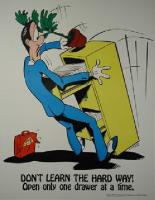Written by The Advanced Commercial Interiors Team
With the average office worker spending around 40 hours per week in the office, it is imperative that every office is designed with health and safety in mind! Nowadays, thanks to the likes of Google and Facebook with their fancy office spaces, many companies want to add as much creative flare as possible into their space. However, you must ensure that this new era of creativity does not interfere with the all important health & safety aspect!
It is very easy to get wrapped up in implementing more creative features within your office, but these can sometimes have a detrimental effect on your staff if not done correctly. With this in mind, we have created this blog post to give you some of the key things you need to look out for when designing your office space to ensure that you are complying with all health and safety regulations, as well as designing an amazing space.
Health & Safety Legislation
The Health and Safety at Work Act (1974) specifies that it is ‘the duty of every employer to ensure so far as is reasonably practicable, the health, safety, and welfare at work of all his employees’. In layman’s terms, this means it is your responsibility as an employer to ensure that your staff are safe from harm whilst at work. This means you need to be sure of a number of things.
You must ensure that you have the correct seating in place, as this is where your staff spend most of their time whilst at work. Beanbags are great, for short periods of time! However, your staff will spend the majority of their time sat at their desks, so investing in the right office chair for your staff is absolutely crucial.
The same needs to be said for the monitors your employees are using. It is great if you want to place them higher so that they look better. However, the monitors need to be placed in an ergonomic position to ensure your staff are comfortable whilst they are using them.
Lighting
One area that is often forgotten about when designing a new workspace is lighting. Having lighting features that look amazing is great, but they need to be practical as well as good-looking! A lot of office spaces are now choosing to move away from uniform LED lighting as employers think this looks dull and bland. But the reality is that it works, and works well! Besides, there are still areas where you can be creative with your office lighting, meeting rooms are a great way to show off your design flare!

Fire Safety
Fire safety is one of the most important things in an office. In the event of a fire, you want to be sure that you are going to be notified about it as soon as possible, but also that you have the available training and equipment to deal with the fire if it is small enough to limit property damage.
This is why investing in both fire detection systems, as well as fire extinguishers, is absolutely crucial! Sure, they don’t look great hanging on the wall of your brand new office space, but they are there to do a job. And in the event that a fire extinguisher is needed, you are going to be so glad that they are there for you!
Layout
The layout of your space is also important. Many employers think that open offices nurture productivity. However, according to a new study, open offices actually reduce face-to-face conversation during work! This study shows that conversation between employees drops significantly, and the amount of instant messenger and email communication is on the rise in an open office. Not only is this bad for productivity, it is bad for your health as well!
If you are using an open office, your employees are going to be spending a lot more time sitting at their desks, sometimes up to 8 hours per day, rather than getting up and moving about to talk to their colleagues. The solution to this may to actually build more walls in your office space to separate departments within your workplace. This will encourage face-to-face conversation, increase productivity and staff wellbeing!
Overall, when you are thinking of creating a new office space, or altering your existing workplace, you need to ensure that you are putting health & safety at the top of your priorities list! Not only will this ensure your staff are happy and healthy when at work, it can also increase productivity! This truly is a win win.
